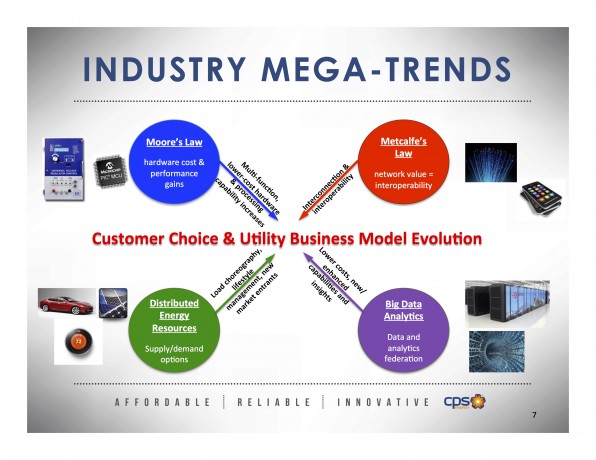This post was originally published on Energized, CPS Energy's blog, and is reposted here with permission.

“Architecture specific, vendor neutral.”
That was the key message from Raiford Smith, CPS Energy’s vice-president of corporate development and planning, to more than two dozen companies, ranging from Fortune 500 firms like Microsoft, Siemens, AT&T, Verizon and Rackspace, to fast-growing, new-energy economy companies like Omnetric, EnerNOC, OPower and Nest Labs, which gathered in San Antonio recently to discuss potential partnerships.
CPS Energy is looking to collaborate with companies on new ways to utilize information and communication technologies with the company’s electric and gas grids, which are in the early stages of transformation into an interoperable network that could support a variety of transformational products and services.
CPS Energy is developing an area on its grid to pilot emerging technology projects, like microgrids, big data analytics, battery storage, data federation via a field message bus, and smart inverters.
Much like Apple and Google have offered their platforms to developers to come up with their own apps, Smith said he sees CPS Energy’s grid of the future as an interoperable platform that could support new and emerging technology.

“We’re looking for ways to be more valuable to our customers, and what they increasingly want is choice in how they utilize energy,” Smith said. “To offer those choices, the utility grid must evolve. Using information and communication technology to unlock and integrate systems in the grid of the future is how we do that. Now we want to know, how can we partner with third parties to deliver value?”
Enabling interoperable platforms to support new services are a key component of what many are calling the “smart cites,” movement, an emerging description for communities that use information and communication technologies to increase quality of life for residents.
“The Smart City movement is about connecting households with information and services that put them in control of their energy use and giving businesses tools to make them more productive,” said Graham Richard, CEO of Advanced Energy Economy and the AEE Institute. “Connectivity, control, big data — these are the elements that will transform the way we live and work in the urban environment.”
AEE, which co-hosted the San Antonio forum with CPS Energy, is a business association that works at the policy level to bolster the growth of advanced energy companies. The group engages the entire range of players in the energy industry, from utilities and their regulators to elected officials and policy experts, and of course, the companies working to create solutions to some of the industry’s most pressing challenges. The AEE Institute is the nonprofit educational arm of the group.
Last June, AEE jointly hosted a CEO forum in San Antonio with CPS Energy to learn more about Texas’ market-based approach to energy, wide scale embrace of wind, the shale gas revolution and the then-recent transition of the electrical grid to a nodal market system.
Attendees’ interest was also piqued by CPS Energy CEO Doyle Beneby’s initiatives, such as reducing the carbon intensity of the utility’s generation fleet by retiring coal and adding natural gas and utility scale solar projects – which have also brought solar panel and component manufacturing to San Antonio, plus CPS Energy’s aggressive energy efficiency and demand response programs.
AEE ultimately invited Beneby to sit on its board of directors, and, as part of its nascent Smart Cities initiative, assembled representatives from companies who might be interested in partnering or piloting with CPS Energy.
“One thing I like about this effort to integrate new business ideas is that you can chip away at it and change the dynamic of our country and our world,” Beneby told the group. “The world is changing, and whether we want to come along willingly or not, we’re facing a lower carbon-based future where innovation is key to our future.”
But he also warned that unless a new economy can be built around such a future, “it’s all interesting, but it’s not relevant. If we are not creating commerce, it’s not sustainable.”
RELATED: